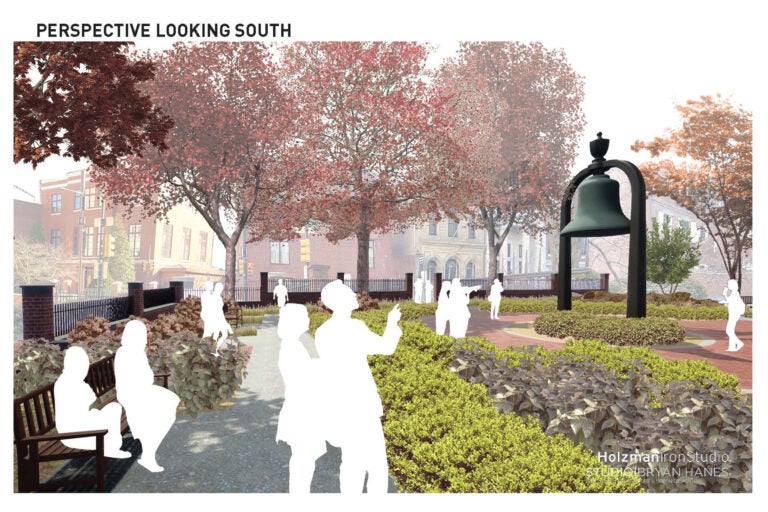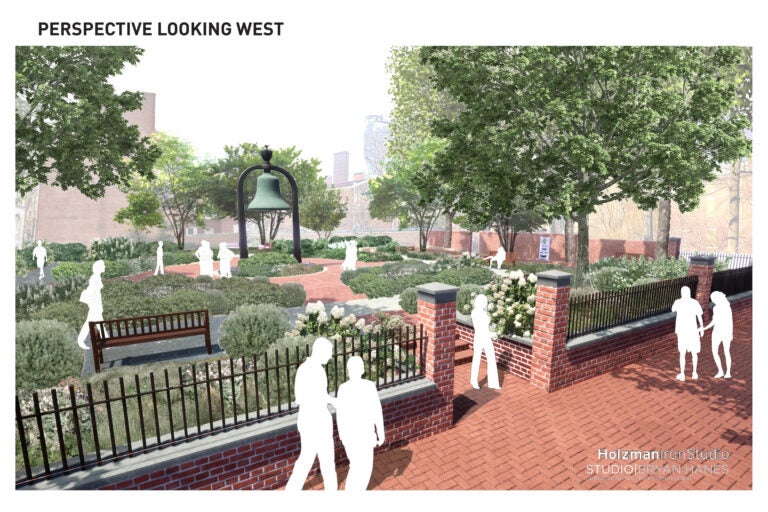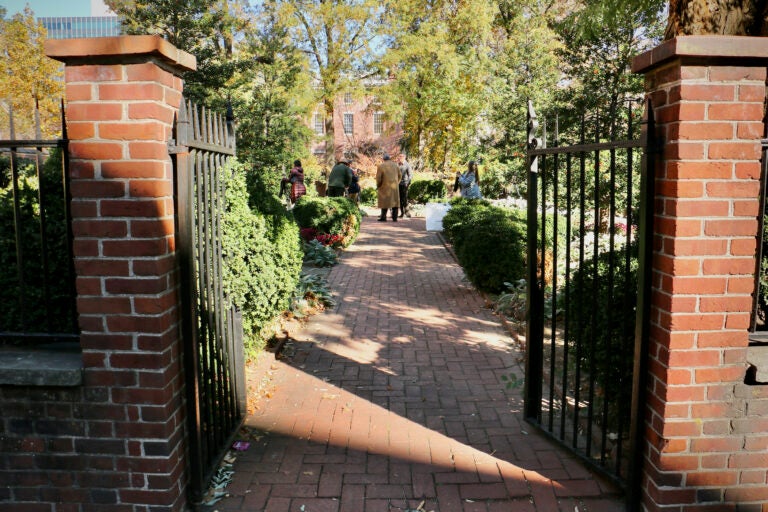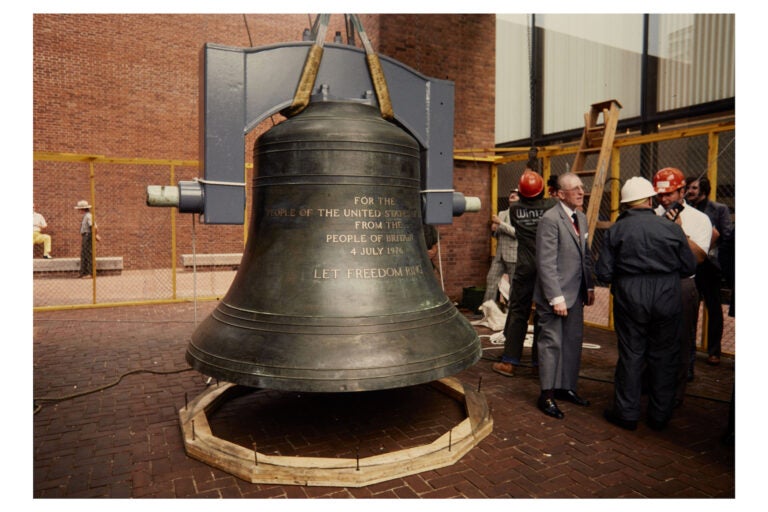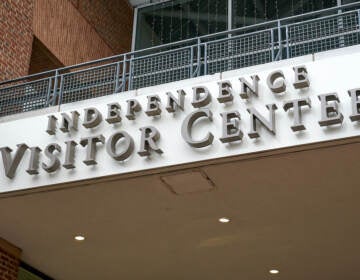The Queen’s bell will live on in Independence Park
The Bicentennial Bell was presented to Philly by Queen Elizabeth II in 1976. It will have a second life in the Benjamin Rush Garden.
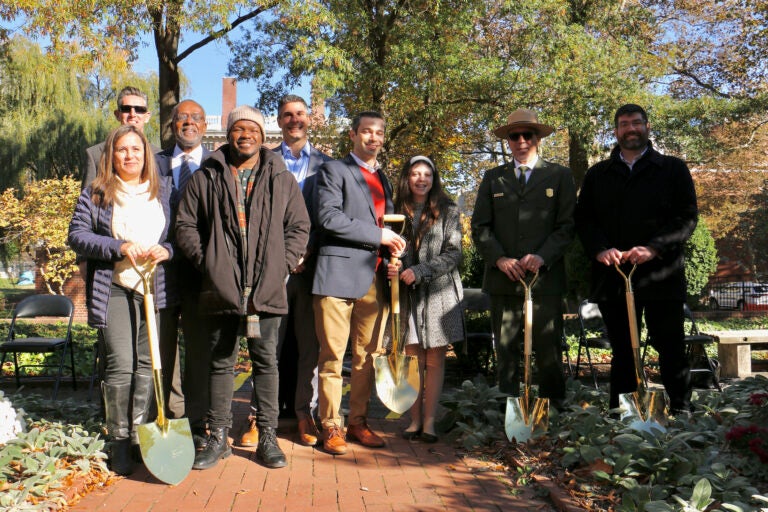
National Park officials, donors, organizers and planners gather to break ground for the Bicentennial Bell Garden, which will replace the Benjamin Rush Garden at 3rd and Walnut streets in Old City. (Emma Lee/WHYY)
From Philly and the Pa. suburbs to South Jersey and Delaware, what would you like WHYY News to cover? Let us know!
On a chilly Friday morning, Jonathan Burton slid a golden-colored shovel into the ground cover of the Benjamin Rush Garden of Independence National Historic Park.
To build a new home for the Bicentennial Bell, gifted to Philadelphia by Queen Elizabeth II in 1976, the 18th century-style garden on what used to be Rush’s house will be completely uprooted.
“All of it. All the plant material will be ripped out and replaced,” he said.

Burton is the development director of the Independence Historical Trust, a fundraising organization that supports capital projects in Independence National Historical Park. The park is spending about $2 million to prepare a space for the Bicentennial Bell to return to the public.
Queen Elizabeth II gave the bell to the National Park in 1976, to commemorate the nation’s Bicentennial. The bell was made in the same forge as the Liberty Bell.

But after the bicentennial ceremony with Queen Elizabeth and Prince Phillip, few people could see the bell: It lived high in a brick bell tower over what had been the Visitors Center at 3rd and Chestnut streets.
When that center was torn down about 10 years ago to make way for the Museum of the American Revolution, the bell disappeared into storage.
Burton said the bell will be back on view next summer, this time at ground level surrounded by a garden, in plenty of time for the nation’s semiquincentennial.
“When you’re given a gift from Queen Elizabeth and the people of England to commemorate 200 years of independence, and now we’re approaching 250 years of independence and the bell they gave us is in storage — it’s not a good look, right?” he said.
It has taken about 10 years to raise the funds from private and public sources to pay for the armature on which the bell will hang, and to renovate the garden. It will be given a new irrigation system, new lighting, and new plants that symbolize the relationship between the two countries. The shrubbery will represent the kinds of botanicals that were historically traded between England and a young United States.
The planning process for what will be called the Bicentennial Bell Garden began as soon as the old Visitors Center was torn down, during the tenure of superintendent Cynthia MacLeod. She retired last spring.
“We considered putting it on the mall with the Liberty Bell, and thought that would be a little confusing,” MacLeod said. “I think it’s confusing, anyway. We have a lot of bells, right?”
There are at least six historic bells and clocks in and around Independence National Historical Park, seven if you include the revived Bicentennial Bell.
The site of the garden was once the home of Benjamin Rush, a physician, civic leader, and Founding Father who signed the original Declaration of Independence. But the garden has aged. MacLeod said it has needed an overhaul for some time.
“The brick is a little bit wonky. The boxwood — half of them have had to be removed because of disease,” she said. “We lament the loss of the holly trees, but sometimes you have to lose a little to move forward.”
This is not the only capital project afoot in Independence Park: Renovations of the nearby First Bank of the United States began about a month ago, to turn the building into a museum of the American economy. That is expected to be completed in time for the semiquincentennial in 2026.
Editor’s note: WHYY President and CEO Bill Marrazzo serves as chair of the Independence Historical Trust.

Get daily updates from WHYY News!
WHYY is your source for fact-based, in-depth journalism and information. As a nonprofit organization, we rely on financial support from readers like you. Please give today.




